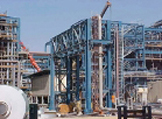Painting Terms

Learn Painting Terms - G
Browse Our Painting Terms
Gable - The end of a building; the triangular end of an exterior wall below the eaves; the end of a ridged roof which, at its extremity, is not returned on itself but is cut off in a vertical plane which is triangular in shape due to the slope of the roof.
Galvanizing - A coating of factory-applied zinc which prevents rust when applied to iron or steel.
Ghosting - A shadowed effect caused by an inconsistent sheen.
Glass Shot Blasting - A abrasive blasting process which employs small glass particles as the suspended material.
Glaze - A term used to describe several types of finishing materials. (1) Glazing putty is of a creamy consistency and is applied to fill imperfections in the surface. (2) A glazing stain is a pigmented stain applied over a stained, filled or painted surface to soften or blend the original color without obscuring it. (3) A glaze coat is a clear finish applied over previously coated surfaces to create a gloss finish.
Glazing Compound - A caulk, sealant, or putty that is used to seal a glass pane into its frame.
Gloss - The luster or shininess of paints and coatings. Different types of gloss are frequently arbitrarily differentiated, such as sheen, distinctness-of-image gloss, etc. Trade practice recognizes the following gloss levels, in increasing order of gloss - flat (or matte) - practically free from sheen, even when viewed from oblique angles (usually less than 15 on 60-degree meter); eggshell - usually 20-35 on 60-degree meter; semi-gloss--usually 35-70 on 60-degree meter; full-gloss -smooth and almost mirror-like surface when viewed from all angles, usually above 70 on 60-degree meter.
Gloss Loss - Accelerated deterioration of the top coat causing rapid luster loss, usually in reds, oranges and yellow paints. Usually caused by - use of gloss alkyd or oil based paint exposed directly to sun; or thin paint film.
Gloss Meter - An instrument using a standard scale to measure the amount of light reflected by paint.
Gloss Retention - The ability of a coating to maintain its gloss - pertains especially to semi-gloss and gloss exterior coatings
Glycol - A co-solvent, combined with water in aqueous (latex) systems to form the total thinner. Various glycols perform various functions, however, they are generally valuable as brushing agents and for temperature stability (ethylene glycol is the chief ingredient in anti-freeze). Generically, CH2OHCH2OH. General term for dihydric alcohols; ethylene glycol is the most simple of the glycols.
Grain - The direction, size, arrangement or appearance of the fibers in wood or veneer.
Grain Cracking - Cracking of a coating, parallel to the grain of the wood substance.
Grain Raising - Swelling and standing up of the wood grain caused by absorbed water or solvents.
Grain - The direction, size and arrangement of the fibers in wood.
Graining - Simulating the grain of wood by means of specially prepared colors or stains and the use of graining tools or special brushing techniques.
Grass Cloth - A paper-backed wallcovering material made from arrowroot bark.
Greenhorn - Someone new to the industry, trade or craft.
Grit Blasting - An abrasive blasting process in which steel grit material is blasted at high pressure at an object's surface.
Grit Number - A number assigned to the coarseness of sandpaper.
Ground Coat - The base coat in an antiquing system that is applied before the graining colors, glazing or other finish coat.
Grunt - An unskilled laborer only used for heavy work.
Guide Coat - A thin coat of paint applied before rubbing down a surface, used as a guide for showing high spots.
Gypsum - A naturally-occurring mineral consisting of calcium sulfate combined with two molecules of water, in crystalline form.
Gypsum Wallboard - A prefabricated sheet used in drywall construction as a substitute for plaster. It's made of gypsum or anhydrite plaster, usually enclosed between two sheets of heavy paper, which can be painted, textured or wallpapered.
Call Now - 1.800.354.9165 - Toll Free









